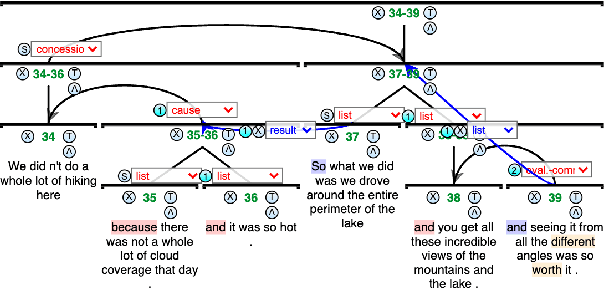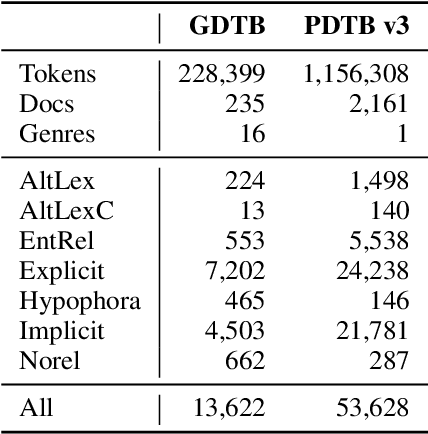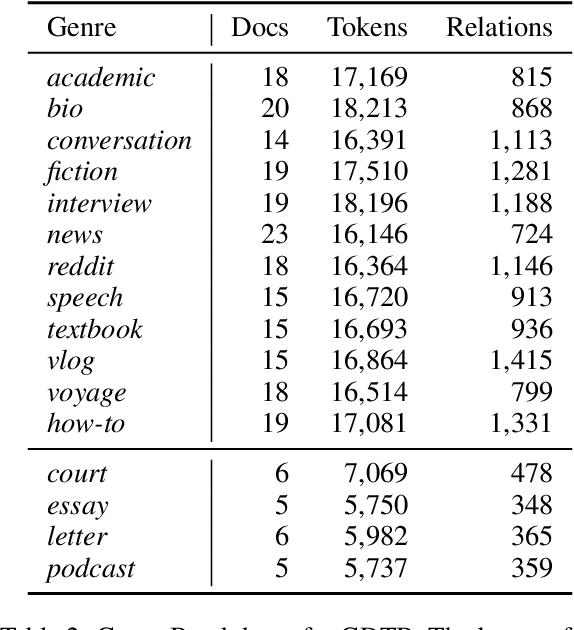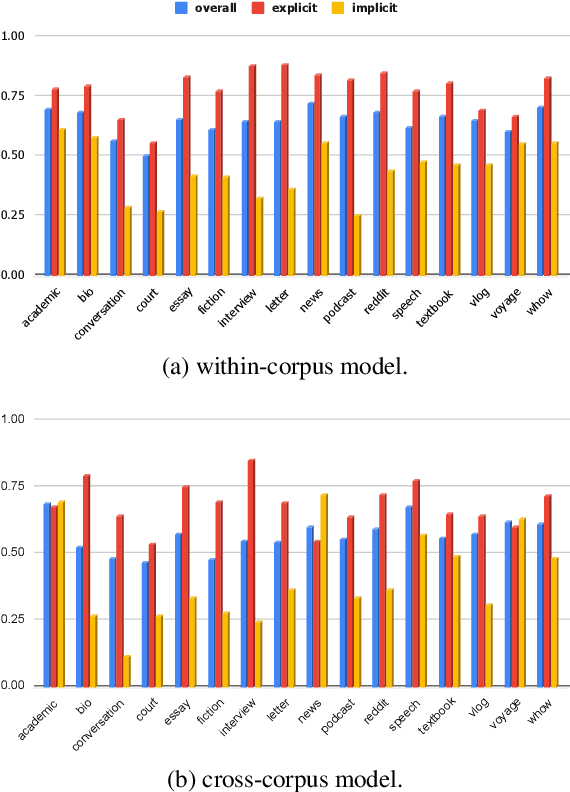Amir Zeldes
IDSL, INRIA Saclay - Ile de France
GUM-SAGE: A Novel Dataset and Approach for Graded Entity Salience Prediction
Apr 15, 2025Abstract:Determining and ranking the most salient entities in a text is critical for user-facing systems, especially as users increasingly rely on models to interpret long documents they only partially read. Graded entity salience addresses this need by assigning entities scores that reflect their relative importance in a text. Existing approaches fall into two main categories: subjective judgments of salience, which allow for gradient scoring but lack consistency, and summarization-based methods, which define salience as mention-worthiness in a summary, promoting explainability but limiting outputs to binary labels (entities are either summary-worthy or not). In this paper, we introduce a novel approach for graded entity salience that combines the strengths of both approaches. Using an English dataset spanning 12 spoken and written genres, we collect 5 summaries per document and calculate each entity's salience score based on its presence across these summaries. Our approach shows stronger correlation with scores based on human summaries and alignments, and outperforms existing techniques, including LLMs. We release our data and code at https://github.com/jl908069/gum_sum_salience to support further research on graded salient entity extraction.
GDTB: Genre Diverse Data for English Shallow Discourse Parsing across Modalities, Text Types, and Domains
Nov 01, 2024



Abstract:Work on shallow discourse parsing in English has focused on the Wall Street Journal corpus, the only large-scale dataset for the language in the PDTB framework. However, the data is not openly available, is restricted to the news domain, and is by now 35 years old. In this paper, we present and evaluate a new open-access, multi-genre benchmark for PDTB-style shallow discourse parsing, based on the existing UD English GUM corpus, for which discourse relation annotations in other frameworks already exist. In a series of experiments on cross-domain relation classification, we show that while our dataset is compatible with PDTB, substantial out-of-domain degradation is observed, which can be alleviated by joint training on both datasets.
Unifying the Scope of Bridging Anaphora Types in English: Bridging Annotations in ARRAU and GUM
Oct 02, 2024Abstract:Comparing bridging annotations across coreference resources is difficult, largely due to a lack of standardization across definitions and annotation schemas and narrow coverage of disparate text domains across resources. To alleviate domain coverage issues and consolidate schemas, we compare guidelines and use interpretable predictive models to examine the bridging instances annotated in the GUM, GENTLE and ARRAU corpora. Examining these cases, we find that there is a large difference in types of phenomena annotated as bridging. Beyond theoretical results, we release a harmonized, subcategorized version of the test sets of GUM, GENTLE and the ARRAU Wall Street Journal data to promote meaningful and reliable evaluation of bridging resolution across domains.
Lacuna Language Learning: Leveraging RNNs for Ranked Text Completion in Digitized Coptic Manuscripts
Jul 17, 2024Abstract:Ancient manuscripts are frequently damaged, containing gaps in the text known as lacunae. In this paper, we present a bidirectional RNN model for character prediction of Coptic characters in manuscript lacunae. Our best model performs with 72% accuracy on single character reconstruction, but falls to 37% when reconstructing lacunae of various lengths. While not suitable for definitive manuscript reconstruction, we argue that our RNN model can help scholars rank the likelihood of textual reconstructions. As evidence, we use our RNN model to rank reconstructions in two early Coptic manuscripts. Our investigation shows that neural models can augment traditional methods of textual restoration, providing scholars with an additional tool to assess lacunae in Coptic manuscripts.
UCxn: Typologically Informed Annotation of Constructions Atop Universal Dependencies
Mar 26, 2024Abstract:The Universal Dependencies (UD) project has created an invaluable collection of treebanks with contributions in over 140 languages. However, the UD annotations do not tell the full story. Grammatical constructions that convey meaning through a particular combination of several morphosyntactic elements -- for example, interrogative sentences with special markers and/or word orders -- are not labeled holistically. We argue for (i) augmenting UD annotations with a 'UCxn' annotation layer for such meaning-bearing grammatical constructions, and (ii) approaching this in a typologically informed way so that morphosyntactic strategies can be compared across languages. As a case study, we consider five construction families in ten languages, identifying instances of each construction in UD treebanks through the use of morphosyntactic patterns. In addition to findings regarding these particular constructions, our study yields important insights on methodology for describing and identifying constructions in language-general and language-particular ways, and lays the foundation for future constructional enrichment of UD treebanks.
SPLICE: A Singleton-Enhanced PipeLIne for Coreference REsolution
Mar 25, 2024Abstract:Singleton mentions, i.e.~entities mentioned only once in a text, are important to how humans understand discourse from a theoretical perspective. However previous attempts to incorporate their detection in end-to-end neural coreference resolution for English have been hampered by the lack of singleton mention spans in the OntoNotes benchmark. This paper addresses this limitation by combining predicted mentions from existing nested NER systems and features derived from OntoNotes syntax trees. With this approach, we create a near approximation of the OntoNotes dataset with all singleton mentions, achieving ~94% recall on a sample of gold singletons. We then propose a two-step neural mention and coreference resolution system, named SPLICE, and compare its performance to the end-to-end approach in two scenarios: the OntoNotes test set and the out-of-domain (OOD) OntoGUM corpus. Results indicate that reconstructed singleton training yields results comparable to end-to-end systems for OntoNotes, while improving OOD stability (+1.1 avg. F1). We conduct error analysis for mention detection and delve into its impact on coreference clustering, revealing that precision improvements deliver more substantial benefits than increases in recall for resolving coreference chains.
eRST: A Signaled Graph Theory of Discourse Relations and Organization
Mar 20, 2024Abstract:In this article we present Enhanced Rhetorical Structure Theory (eRST), a new theoretical framework for computational discourse analysis, based on an expansion of Rhetorical Structure Theory (RST). The framework encompasses discourse relation graphs with tree-breaking, nonprojective and concurrent relations, as well as implicit and explicit signals which give explainable rationales to our analyses. We survey shortcomings of RST and other existing frameworks, such as Segmented Discourse Representation Theory (SDRT), the Penn Discourse Treebank (PDTB) and Discourse Dependencies, and address these using constructs in the proposed theory. We provide annotation, search and visualization tools for data, and present and evaluate a freely available corpus of English annotated according to our framework, encompassing 12 spoken and written genres with over 200K tokens. Finally, we discuss automatic parsing, evaluation metrics and applications for data in our framework.
GUMsley: Evaluating Entity Salience in Summarization for 12 English Genres
Jan 31, 2024Abstract:As NLP models become increasingly capable of understanding documents in terms of coherent entities rather than strings, obtaining the most salient entities for each document is not only an important end task in itself but also vital for Information Retrieval (IR) and other downstream applications such as controllable summarization. In this paper, we present and evaluate GUMsley, the first entity salience dataset covering all named and non-named salient entities for 12 genres of English text, aligned with entity types, Wikification links and full coreference resolution annotations. We promote a strict definition of salience using human summaries and demonstrate high inter-annotator agreement for salience based on whether a source entity is mentioned in the summary. Our evaluation shows poor performance by pre-trained SOTA summarization models and zero-shot LLM prompting in capturing salient entities in generated summaries. We also show that predicting or providing salient entities to several model architectures enhances performance and helps derive higher-quality summaries by alleviating the entity hallucination problem in existing abstractive summarization.
Incorporating Singletons and Mention-based Features in Coreference Resolution via Multi-task Learning for Better Generalization
Sep 20, 2023Abstract:Previous attempts to incorporate a mention detection step into end-to-end neural coreference resolution for English have been hampered by the lack of singleton mention span data as well as other entity information. This paper presents a coreference model that learns singletons as well as features such as entity type and information status via a multi-task learning-based approach. This approach achieves new state-of-the-art scores on the OntoGUM benchmark (+2.7 points) and increases robustness on multiple out-of-domain datasets (+2.3 points on average), likely due to greater generalizability for mention detection and utilization of more data from singletons when compared to only coreferent mention pair matching.
What's Hard in English RST Parsing? Predictive Models for Error Analysis
Sep 10, 2023Abstract:Despite recent advances in Natural Language Processing (NLP), hierarchical discourse parsing in the framework of Rhetorical Structure Theory remains challenging, and our understanding of the reasons for this are as yet limited. In this paper, we examine and model some of the factors associated with parsing difficulties in previous work: the existence of implicit discourse relations, challenges in identifying long-distance relations, out-of-vocabulary items, and more. In order to assess the relative importance of these variables, we also release two annotated English test-sets with explicit correct and distracting discourse markers associated with gold standard RST relations. Our results show that as in shallow discourse parsing, the explicit/implicit distinction plays a role, but that long-distance dependencies are the main challenge, while lack of lexical overlap is less of a problem, at least for in-domain parsing. Our final model is able to predict where errors will occur with an accuracy of 76.3% for the bottom-up parser and 76.6% for the top-down parser.
 Add to Chrome
Add to Chrome Add to Firefox
Add to Firefox Add to Edge
Add to Edge